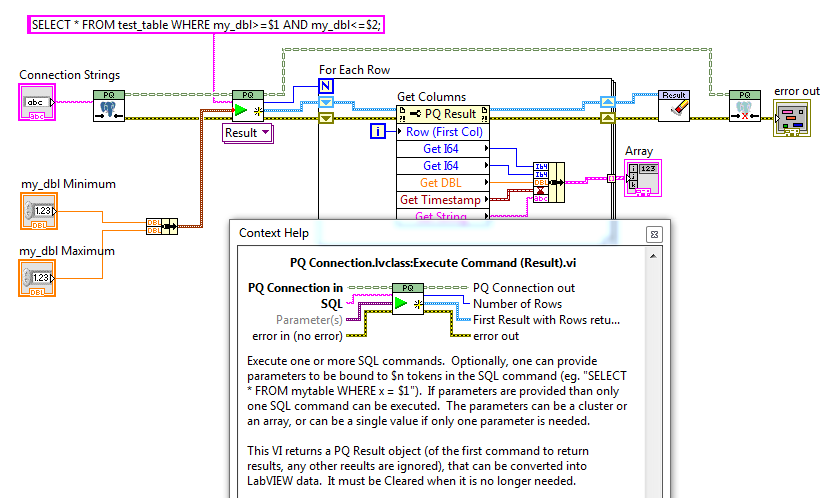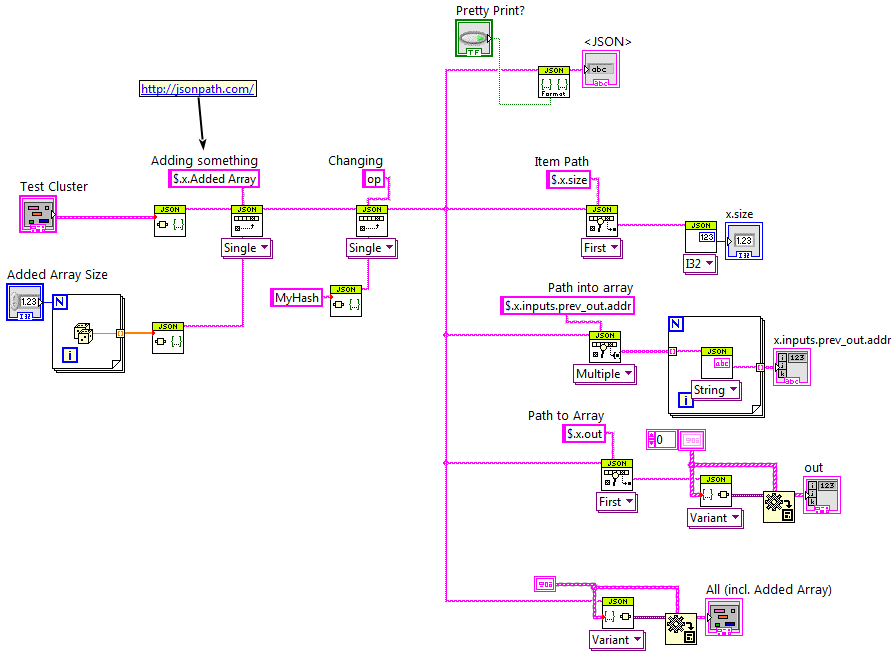-
Posts
1,986 -
Joined
-
Last visited
-
Days Won
183
Content Type
Profiles
Forums
Downloads
Gallery
Posts posted by drjdpowell
-
-
TDMS is much more specialised than the more general-purpose SQLite. If your use case is well within what it is designed for (and it sounds like it is) then it is likely the better choice.
-
You didn't make them from scratch; you used available components (such as lawnmowers, brakes, engines, etc.) all of which you accepted as not being sabotaged by someone who wanted to kill you. An MOT is a non-onerous test, involving a reasonable set of requirements, so that sounds like a good idea. It would be a LOT of work to pass an MOT without using components manufactured by other people.
-
1 hour ago, ShaunR said:
A) will definitely kill you wheras B) Probably won't since it is a design requirement not to kill you. If that isn't obvious then I despair

Or. Looking at it another way.
The goal of writing software is to succeed and realise the requirements. Would you prefer A) or B) to be successful and the contingencies employed to ensure success to drive towards A) or B)?
Nobody makes their own car because no-one is trying to sabotage their car, and driving a car built by yourself is extremely dangerous. If you think someone might try to kill you, then you still don’t build your own car. Instead, you verify that no-one has tampered with your car.
I was just wondering how that kind of analysis goes with software, and whether management, in it’s insistence on no open source or onerous verification requirements, is actually making the correct choice as far as minimizing risk.
-
But which is the bigger risk of this example:
A) Someone will sell me a car that has been modified to crash and kill me.
B) The car that I build from scratch will crash and kill me.
Mitigating (A) by accepting (B) is not necessarily reducing your chance of death.
-
10 hours ago, ShaunR said:
When I say "obvious". I mean in the same sense that the prospect of being beaten senseless on a Friday night is intuitively worse and riskier than tripping over and possibly hurting yourself even though I don't know the probabilities involved.
I’m not sure intuition is that reliable in such high-importance-but-low-likelyhood things. People die from mundane things like tripping over.
-
I wonder how large the risk of malicious code is relative to the risk of serious bugs in code implemented from scratch.
-
 1
1
-
-
Anybody using Postgres who would like to beta test my libpq-based library? It’s similar to my SQLite access library.

-
 1
1
-
-
You’re running out of memory because you are copying the giant string somewhere. If you never alter the string, but instead work along it using the “offset” inputs on the string functions, then you can use all the loops you like.
-
 1
1
-
-
1 hour ago, JamesMc86 said:
Sometimes in config files I will use the key-value mode to read what items are in the object to help with defaults if missing or version migration which I guess isn't the intention of this API but that's the only case I have that this wouldn't work for.
Oh that IS a use case. Though lookup is much slower than with a Variant-Attribute-based object, it is much faster than doing the initial conversion to that object, so one is well ahead overall if one only needs to do a few lookups.
-
Here's an alpha version to look at, with one example, just to show the API:

jdp_science_jsontext-0.1.0.4.vip
This is VERY untested.
-
4 hours ago, smithd said:
My point here is that as part of the json generation step for me, I'm passing in a large binary string which has to be escaped and handled by the flatten to json function.
Be careful if you use the NI function to get your binary data back, as it has bug in that will truncate the string at the first zero, even though that zero is properly escaped as \u0000. Png files might or might not have zeros in them, but other binary things do (flattened LVOOP objects, for example).
-
11 hours ago, smithd said:
One thing I can say for sure is I've never needed the in-memory key-value features of the lava API. I just use the json stuff as an interchange, so all those objects only ever go in one function.
I have only used it that way a bit. And that was basically for recording attributes of a dataset as it passed through a chain of analysis. I was only adding things at a few places before the result got saved to disk/database. The new JSONtext library has Insert functions to add/change values. These are slower than the old library, but not so much as to make up for the expensive conversion to/from LVOOP objects, unless one is doing hundreds of inserts. If someone is using LAVA-JSON objects in such a way, I would like to know about it.
-
30 minutes ago, ShaunR said:
If you want bigger JSON streams then the bitcoin order books are usually a few MB
I've had a client hand me a 4GB JSON array, so I'm OK for large test cases.

-
22 minutes ago, ShaunR said:
300MB/sec?

Only 125MB/sec, but I was testing calling 'SELECT json_extract($json,$path)' which has the extra overhead of getting the JSON string in and out of the db. I wish I could match 300MB/sec in LabVIEW.
-
 1
1
-
-
2 hours ago, ShaunR said:
I don't use any of them for this sort of thing. They introduced the JSON extension as a build option in SQLite so it just goes straight in (raw) to an SQLite database column and you can query the entries with SQL just as if it was a table. It's a far superior option (IMO) to anything in LabVIEW for retrieving including the native one.
I prototyped using an in-memory SQLite DB to do JSON operations, but I can get comparable speed by direct parsing. But using JSON support in a Database is a great option.
-
Some performance numbers:
I took the "Message on new transaction" JSON from the blockchain.info link that Shaun gave, created a cluster for it, and compared the latest LAVA-JSON-1.4.1**, inbuilt NI-JSON, and my new JSONtext stuff for converting JSON to a cluster.
- LAVA-JSON: 7.4 ms
- NI-JSON: 0.08 ms
- JSONtext: 0.6 ms
Then I added a large array of 10,000 numbers to bulk the array out by 50kB.
If I add the array to the Cluster I get these numbers:
- LAVA-JSON: 220 ms
- NI-JSON: 5.6 ms
- JSONtext: 9.0 ms (I pass the large array to NI-JSON internally, which is why I'm closer)
If I don't add the array to the cluster (say, I'm only interested in the metadata of a measurement):
- LAVA-JSON: 135 ms
- NI-JSON: 5.2 ms
- JSONtext: 1.1 ms
The NI tools appear to vet everything very carefully, even unused elements, while I do the minimal checking needed to parse past the large array (in fact, if I find all cluster elements before reaching the array, I just stop, meaning the time to convert is 0.6 ms, as if the array wasn't there).
**Note: earlier LAVA-JSON versions would be notably worse, especially for the large case.
-
6 hours ago, smithd said:
-Handle enums and timestamps and similar common types without being whiny about how its not in the standard (yet apparently changing the standard for DBL types was just fine).
-Discover and read optional components (technically possible with lv api, but pretty wasteful and also gross).
-I love the lava api's pretty-print.I’d add:
- Work on a stream (i.e. allow the JSON Value to be followed by something else, like the regular Flatten functions have a “Rest of String” output).
- Give useful error messages that include where in the very long JSON text the parser had an issue.
- Work with “sub”JSON. Meaning, “I know there is an “Options” item, but it can come in multiple forms, so just return me that item as JSON so I can do more work on it (or pass it on to an application subcomponent that does know what the form is).
The library I’m working on, JSONtext, is trying to be sort of an extension to the inbuilt JSON primitives that adds all these features.
-
 1
1
-
-
8 hours ago, ShaunR said:
The other JSON library was just too slow for streaming Websockets and the NI primitive is as much use as a chocolate fireguard because it crashes out if anything isn't quite right.
One of the performance advantages of working directly with JSON strings is that, when converting JSON to/from a Variant, one can use the NI primitives to handle large numeric arrays, without ever letting it see (and throw a fit over) the entire string. In fact, I can often pull out selected elements of a large JSON text faster than using the NI primitive’s “path” input (I think because the primitive insists on parsing the entire string for errors, while I don’t).
-
I’m working on a new JSON library that I hope will be much faster for my use cases. It skips any intermediate representation (like the LVOOP objects in the LAVA JSON API, or the Variants in some other JSON toolkits) and works directly on JSON text strings. I’d like to avoid making a tool just for myself, so I’d like to know what other people are using JSON for. Is anyone using JSON for large(ish) data? Application Config files? Communication with remote non-LabVIEW programs? Databases?
-
1 hour ago, Neil Pate said:
One minor thing which I have not investigated the reason for yet is that you cannot resize the tree column widths.
XControls don’t automatically save display properties of their contained controls; one has to explicitly save/load in special methods of the XControl. A big pain, given the large number of properties.
-
It’s Ton Plomp’s XControl, I’d guess.
-
After studying documentation, my current plan is to use Postgresql with its libpq client dll. I think I can wrap libpq in a similar way to what I did with SQLite.
-
Anybody used Postgresql?
-
What toolkits do people use for accessing databases? I’ve been using SQLite a lot, but now need to talk to a proper database server (MySQL or Postgres). I’ve used the NI Database Connectivity Toolkit in the (far) past, but I know there are other options, such as using ADO.NET directly.
What do people use for database connectivity? What would you recommend?
— James



Choice of logging format/style [TDMS, SQLite, some combination?]
in Database and File IO
Posted
Actually, at least up to the 2GB files I’ve tested, the SQLite file gets held in memory by Windows File Cache, so refreshing is fast (though the initial read will be slower with an HDD than an SSD, as will be writing).